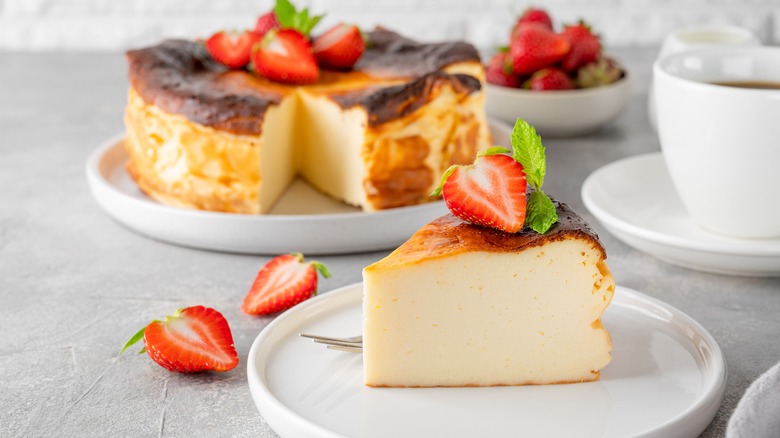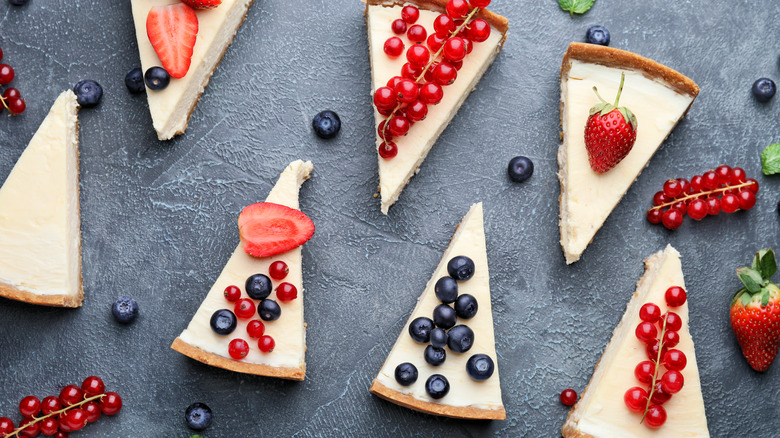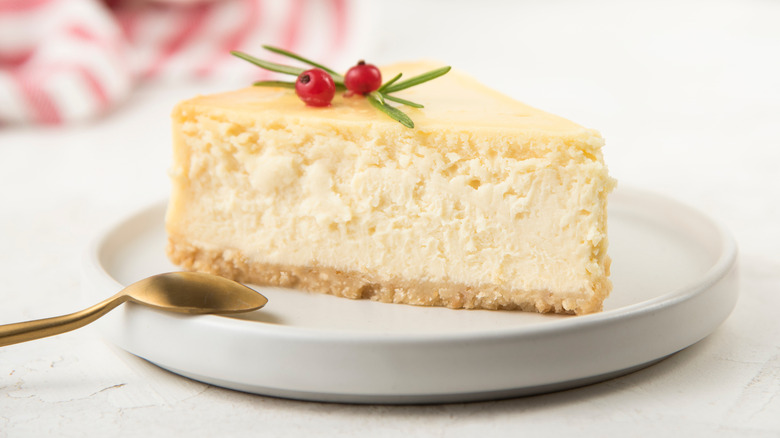The Reason Cheesecake Isn't Technically Cake
Most fans might think of cheesecake as a uniquely American dessert, but the sweet treat beloved by millions actually predates the founding of the United States by a few millennia, all the way back to ancient Greece. Chefs then crafted it by combining fresh cheese with flour and honey, then pounding that mixture flat before cooking it on clay cookware, per New York cheesecake brand Junior's. Credit for the first-ever cheesecake recipe, however, goes to Greek writer Athenaeus, who jotted down a record in 230 A.D. — even though the dessert had already been around for centuries (via Cheesecake.com).
Changes to this recipe were made after the Romans conquered Greece — including the addition of crumbled cheese and eggs and the use of pastry to contain the filling. And when the Romans grew their empire across Europe, they introduced their cheesecake to the cultures they interacted with, resulting in each region adapting it to create a local version.
Cheesecake didn't take on the form as we know it today until the 18th century, as seen in Martha Washington's cookbook from that time period, which features cheesecake recipes flavored with rosewater, spices, and currants. By the 19th century, other flavors such as lemon and vanilla were introduced, and by the early 20th century, the idea of using cream cheese or Neufchatel — one type of unique cheese you need to try at least once in your lifetime – came up in recipes for "cream cheese pie" and "cream cheese cake."
Different ways of preparing cheesecake
Since cheesecake recipes didn't remained static, it should come as no surprise that there are many varieties of cheesecake today. For example, Lacademie lists thirteen different types of the dessert, including New York-style cheesecake, a dense version that gains extra heft with the addition of heavy cream, eggs, sugar, and a lot of cream cheese; the lighter classic rendition; no-bake cheesecake; the airy Japanese "cotton" cheesecake; and vegan cheesecake, often made from silken tofu or cashew nuts and coconut milk.
That's not all. Chicago also has its own style of the dessert that's fluffy and has a shortbread crust. Russian cheesecake — called vatrushka — comes in the form of ring-shaped pierogi. Plus, there's the distinctive Basque cheesecake with its burnt top layer, the Italian ricotta-based cheesecake, and other European cheesecakes. The Germans make theirs with quark or sour cream – known to be two of the best substitutes for ricotta; the Swedish use a mixture of rennet, warm milk, and flour for their version; and the Austrians like putting two sponge cakes together with quark in the middle for their take on cheesecake.
Though cheesecake comes in many forms and flavors, one thing remains the same across all varieties: It isn't cake.
Why cheesecake is not considered a cake
Cheesecake's status as "not cake" comes down to the technical definition of cake as set by culinary experts like Harold McGee. In his book "On Food and Cooking," McGee defines cake as a dessert that typically contains four main ingredients — flour, eggs, sugar, and butter (or alternatives such as shortening) — and involves leavening, as seen in traditional ones like the English pound cake.
More recently, celebrity chef Alton Brown reignited discussions that cheesecake is not cake by tweeting in 2020: "Let me put this to rest: cheesecake is pie." He later added: "Cheesecake is in fact a custard pie. Don't bother replying in the negative. Just adjust your world view and move on with life" (via Twitter).
No matter how it is prepared and served, cheesecake will never be cake because, as Junior's points out, the dessert — with its composition of soft cheese, eggs, and sugar — will always be a baked custard.


